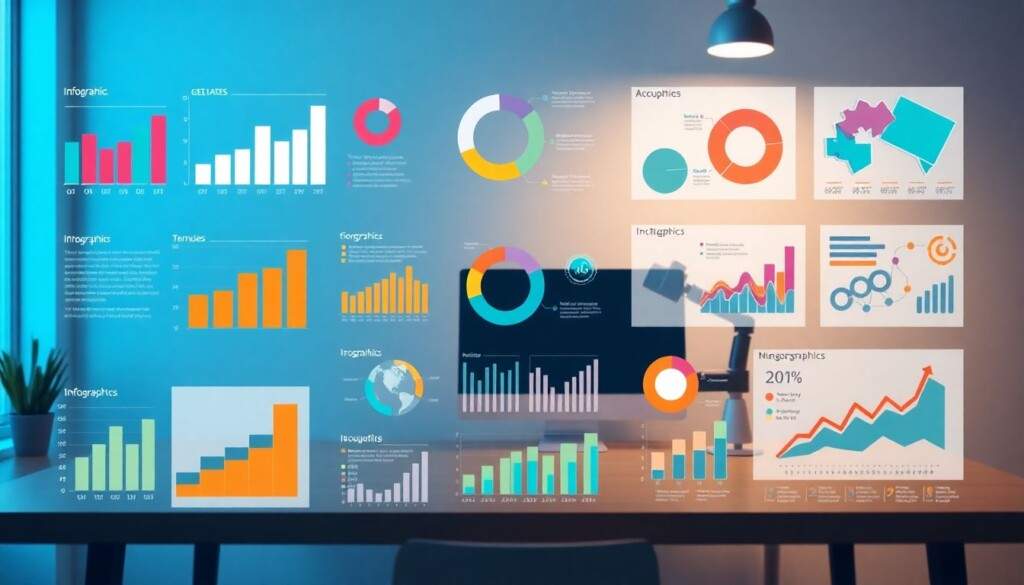Infographics are powerful tools in content marketing, taking engagement to new heights. Studies show that visual content, like infographics, can increase engagement rates by up to 94% compared to text-only formats. In a world where attention spans are short, infographics effectively convey complex information quickly and attractively. This article will guide you through the process of designing eye-catching infographics that boost engagement and enhance your content strategy.
Understanding Your Audience and Purpose
Identifying your target audience
Getting to know your audience is crucial. Who are they? What are their interests? Understanding demographics and knowledge levels helps tailor your infographic. For instance, analyze audience data from previous campaigns to spot trends. Create detailed user personas to visualize your ideal viewer.
- Example: If your target audience is young professionals, focus on modern design and relevant topics.
Defining clear objectives
Every infographic should have a purpose. What do you want viewers to learn? Establishing measurable goals will help track success. Perhaps you want to increase brand awareness or educate your audience—clarifying this direction keeps your design focused.
- Tips: Set goals like increasing click-through rates or shares.
Choosing the right infographic type
Different infographic types serve different needs. Whether it’s a process chart, timeline, or comparison graphic, match the format to your audience and objectives.
- Examples: Use a timeline for historical events or a comparison chart to showcase product features.
Contact me today to start the conversation.
Crafting a Compelling Narrative and Visual Hierarchy
Developing a clear storyline
The organization of information is key. A logical flow helps viewers grasp concepts easily. Arrange details in a way that builds upon foundational knowledge.
- Example: For a timeline infographic, start with the earliest events before progressing.
Prioritizing visual hierarchy
Guide your audience’s eye through the graphic. Use size, color, and placement to highlight what’s important. Headlines should stand out while supporting text remains simpler.
- Tips: Utilize larger fonts for titles and smaller ones for details.
Using whitespace effectively
Clutter can overwhelm viewers. White space provides a visual break, enhancing readability and focus on key points.
- Example: Space out images from text to create an appealing layout.
Choosing the Right Colors, Fonts, and Imagery
Color psychology and brand consistency
Colors can evoke emotions. Choose hues that align with your brand identity and the message you want to convey. For instance, calming blues for tranquility or vibrant reds for urgency.
- Tips: Use a color palette generator to maintain consistency.
Font selection for readability and aesthetics
Fonts should be both attractive and easy to read. A sans-serif font works well for body text, while a serif can add flair to headings.
- Tips: Limit yourself to two or three fonts for a cohesive look.
Using high-quality images and icons
Images can significantly enhance understanding. Opt for professionally designed icons or custom illustrations to bring your infographic to life.
- Tips: Utilize royalty-free images or create your own graphics for uniqueness.
Contact me today to start the conversation.
Designing for Different Platforms and Devices
Responsive design principles
Create infographics that look good on all devices. Use scalable vector graphics (SVGs) to ensure clarity regardless of size.
- Example: Test the infographic on multiple screen sizes to check appearance.
Optimizing for social media sharing
Make content easily shareable by adhering to social media’s optimal dimensions. This maximizes visibility across platforms.
- Tips: Include social media sharing buttons for convenience.
Considering accessibility
Design with everyone in mind. Ensure users with disabilities can also engage with your infographic.
- Example: Adding alt text for images helps screen readers describe visual content.
Contact me today to start the conversation.
Promoting and Analyzing Your Infographic
Sharing your infographic on multiple platforms
To maximize reach, spread your infographic across various platforms—social media, email, and your website can help you gain visibility.
- Example: Share on LinkedIn for professional audiences and Instagram for younger demographics.
Tracking key metrics
Monitoring performance is essential. Check metrics like website traffic and social media shares to gauge effectiveness.
- Tips: Use analytics tools to gather insights about engagement rates.
Iterating based on data
Learn from your successes and failures. Analyze data to improve future infographics, adapting design elements based on audience preferences.
- Example: Conduct A/B testing to see which elements resonate better with viewers.
Conclusion
To sum up, understanding your audience, crafting a logical narrative, selecting appropriate colors and fonts, ensuring responsive design, and analyzing performance are key to creating successful infographics. Now it’s time to put this knowledge to work and create your own engaging infographics. Well-designed visual content can significantly impact your engagement and boost success in your marketing efforts. Get started today!
Contact me today to start the conversation.




